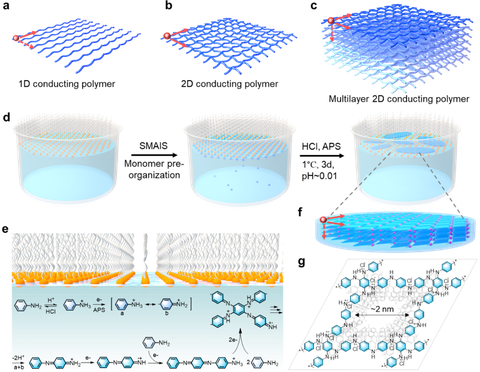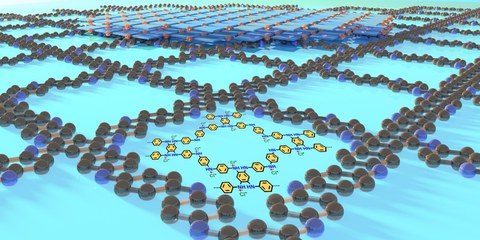Feb 05, 2025
Scientists synthesize 2D polyaniline crystal with unique metallic out-of-plane conductivity
In a recent study published in Nature, an international team of researchers has developed a groundbreaking two-dimensional conducting polymer—polyaniline (2DPANI)—that exhibits exceptional electrical conductivity and metallic charge transport behavior. Unlike conventional conducting polymers, which show strong conduction along polymer chains but suffer from poor interchain/interlayer conductivity, 2DPANI overcomes these limitations with its unique crystal structure, enabling efficient electron flow both within and across its layers.
Conducting polymers such as polyaniline, polythiophene, and polypyrrole are renowned for their excellent electrical conductivity and have emerged as promising low-cost, lightweight, and flexible alternatives to traditional semiconductors and metals. The significance of these materials was cemented in 2000 when the Nobel Prize in Chemistry was awarded to Alan J. Heeger, Alan G. MacDiarmid, and Hideki Shirakawa for their groundbreaking discovery and development of conductive polymers. This recognition highlighted the transformative potential of polymers in modern science and technology. Despite significant progress, these materials mainly conduct electrons along their polymer chains. However, conductivity between the polymer strands or layers remains limited because the molecules don't connect well and the electronic interactions are weak.
To address this long-standing challenge, an international research team from TU Dresden and the Max Planck Institute of Microstructure Physics (Halle, Germany), in collaboration with the Ningbo Institute of Materials Technology and Engineering of the Chinese Academy of Sciences (China), CIC nanoGUNE BRTA (Spain), and others, has synthesized and characterized a multilayer-stacked two-dimensional polyaniline (2DPANI) crystal through the use of on-water surface chemistry. 2D polymerization has now been achieved for individual monomers, e.g., aniline, which typically undergoes chain-growth oxidative polymerization to form polyaniline. The resulting 2DPANI material exhibits exceptional conductivity not only within its planes but also, remarkably, across its layers, demonstrating unique metallic out-of-plane (i.e. across layers) charge transport. The findings, published in Nature under the title “Two-dimensional polyaniline crystal with metallic out-of-plane conductivity,” represent a significant advancement in conducting polymer research.

Schematic of the on-water surface synthesis procedure for 2DPANI.
One of the most striking findings of the study is the Drude-type conductivity observed in 2DPANI crystals through infrared and terahertz near-field microscopy at CIC nanoGUNE in San Sebastián, Spain. These measurements estimate a DC conductivity of approximately 200 S/cm. DC transport studies conducted at the Max Planck Institute of Microstructure Physics (Halle, Germany) show anisotropic conductivity, with 16 S/cm in-plane and 7 S/cm out-of-plane—about three orders of magnitude higher than that of traditional linear conducting polymers. Furthermore, low-temperature measurements show that out-of-plane conductivity increases as temperature decreases—a characteristic behavior of metals—confirming the material’s exceptional metallic out-of-plane electric transport properties.
This breakthrough opens the door to potentially achieving three-dimensional metallic conductivity in metal-free organic and polymer materials, offering exciting new prospects for applications in electronics, electromagnetic shielding, sensors and other devices that leverage the unique properties of organic 2D crystal materials.
DOI number for your paper will be 10.1038/s41586-024-08387-9
https://www.nature.com/articles/s41586-024-08387-9

